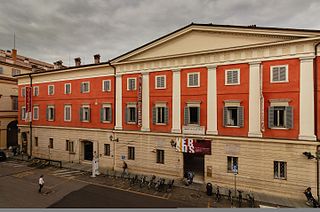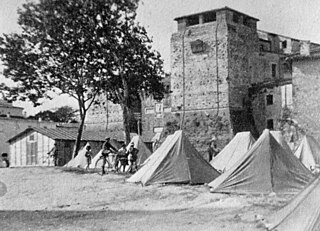
Rimini is a city in the Emilia-Romagna region of Northern Italy.

Pesaro is a comune (municipality) in the Italian region of Marche, capital of the province of Pesaro and Urbino, on the Adriatic Sea. According to the 2011 census, its population was 95,011, making it the second most populous city in the Marche, after Ancona. Pesaro was dubbed the "Cycling City" by the Italian environmentalist association Legambiente in recognition of its extensive network of bicycle paths and promotion of cycling. It is also known as "City of Music", for it is the birthplace of the composer Gioachino Rossini. In 2015 the Italian Government applied for Pesaro to be declared a "Creative City" in UNESCO's World Heritage Sites. In 2017 Pesaro received the European City of Sport award together with Aosta, Cagliari and Vicenza.

Riccione is a comune in the Province of Rimini, Emilia-Romagna, northern Italy.

Ostra is a town and comune in the Marche, central Italy, near the modern Ostra Vetere, south-east of Senigallia.

Cattolica is a town and comune in the Province of Rimini, Italy, with 16,233 inhabitants as of 2007.

Giuseppe Garampi was an Italian scholar and collector of documents and books.
Raffaello "Lello" Baldini, was an Italian poet in the Romagnol language.

The Arch of Augustus is a gate set in the former city wall of Rimini, Emilia-Romagna, in the form of an ancient Roman triumphal arch.

The Palazzo Santa Margherita is a Neoclassical-style palace located on Corso Canalgrande #103 in the central Modena region of Emilia-Romagna in Italy.

Sant'Agostino is a Romanesque-Gothic-style Roman Catholic church located in Via Cairoli in Rimini, Italy. It is one of the city's oldest extant church buildings.
The following is a timeline of the history of the city of Parma in the Emilia-Romagna region of Italy.
The following is a timeline of the history of the city of Vicenza in the Veneto region of Italy.
The following is a timeline of the history of the city of Forlì in the Emilia-Romagna region of Italy.
The following is a timeline of the history of the city of Rimini in the Emilia-Romagna region of Italy.

The Museo della Città is the civic museum located in the former Jesuit convent on Via Luigi Tonini #1 of the city of Rimini, in the region of Emilia-Romagna, Italy. It rises adjacent to Chiesa del Suffragio, and a modern structure built to enclose the ruins of an ancient Roman Domus, or house.
Biblioteca Civica may refer to one of the following public libraries in Italy:

Paolo Fabbri was an Italian semiotician.

In 1916, two earthquakes of magnitude 5.82 occurred near the border between the regions of Romagna and the Marche in the Kingdom of Italy: at 13:50 CEST on 17 May, and at 09:06 CEST on 16 August.
The Villa des Vergers is a countryside villa in San Lorenzo in Correggiano, near Rimini, in the region of Emilia-Romagna, northern Italy. Dating to the 17th century, the villa was purchased by Adolphe Noël des Vergers in 1843, and substantially redesigned in 1879 by Arthur-Stanislas Diet. Between 1938 and 1946, it was owned by Mario Ruspoli, 2nd Prince of Poggio Suasa, who employed Pietro Porcinai to design the villa's gardens. The villa was used as a military headquarters by German forces in the Second World War, and has since been owned by a series of local entrepreneurs.















